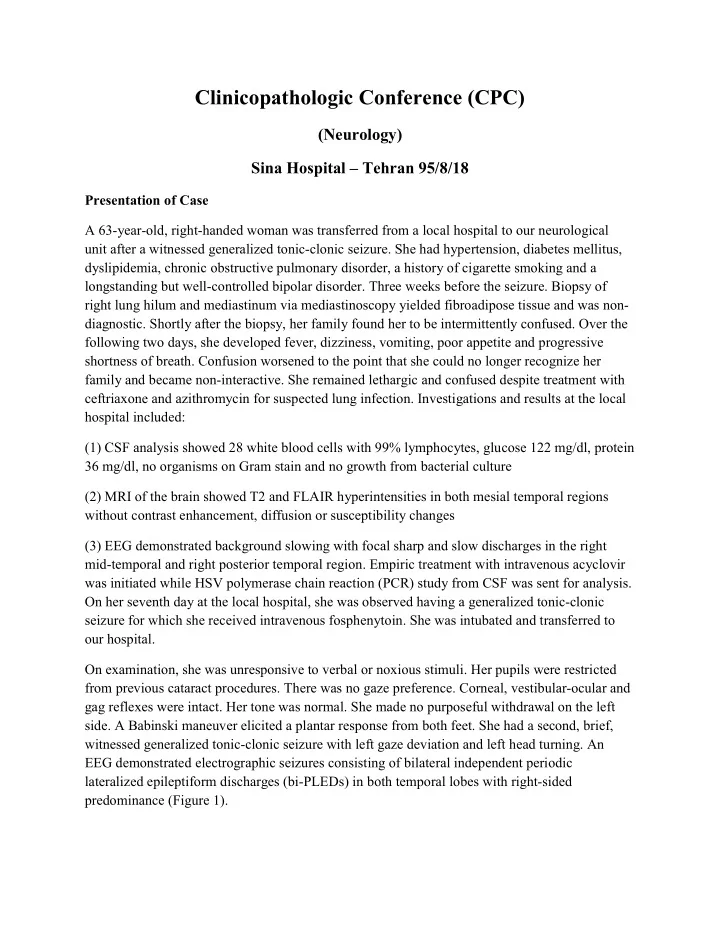

Clinicopathologic Conference (CPC) (Neurology) Sina Hospital – Tehran 95/8/18 Presentation of Case A 63-year-old, right-handed woman was transferred from a local hospital to our neurological unit after a witnessed generalized tonic-clonic seizure. She had hypertension, diabetes mellitus, dyslipidemia, chronic obstructive pulmonary disorder, a history of cigarette smoking and a longstanding but well-controlled bipolar disorder. Three weeks before the seizure. Biopsy of right lung hilum and mediastinum via mediastinoscopy yielded fibroadipose tissue and was non- diagnostic. Shortly after the biopsy, her family found her to be intermittently confused. Over the following two days, she developed fever, dizziness, vomiting, poor appetite and progressive shortness of breath. Confusion worsened to the point that she could no longer recognize her family and became non-interactive. She remained lethargic and confused despite treatment with ceftriaxone and azithromycin for suspected lung infection. Investigations and results at the local hospital included: (1) CSF analysis showed 28 white blood cells with 99% lymphocytes, glucose 122 mg/dl, protein 36 mg/dl, no organisms on Gram stain and no growth from bacterial culture (2) MRI of the brain showed T2 and FLAIR hyperintensities in both mesial temporal regions without contrast enhancement, diffusion or susceptibility changes (3) EEG demonstrated background slowing with focal sharp and slow discharges in the right mid-temporal and right posterior temporal region. Empiric treatment with intravenous acyclovir was initiated while HSV polymerase chain reaction (PCR) study from CSF was sent for analysis. On her seventh day at the local hospital, she was observed having a generalized tonic-clonic seizure for which she received intravenous fosphenytoin. She was intubated and transferred to our hospital. On examination, she was unresponsive to verbal or noxious stimuli. Her pupils were restricted from previous cataract procedures. There was no gaze preference. Corneal, vestibular-ocular and gag reflexes were intact. Her tone was normal. She made no purposeful withdrawal on the left side. A Babinski maneuver elicited a plantar response from both feet. She had a second, brief, witnessed generalized tonic-clonic seizure with left gaze deviation and left head turning. An EEG demonstrated electrographic seizures consisting of bilateral independent periodic lateralized epileptiform discharges (bi-PLEDs) in both temporal lobes with right-sided predominance (Figure 1).
Figure 1: Electroencephalography (low frequency 10 Hz, high frequency 70 Hz) showing epileptiform activity is comprised of bilateral independent periodic lateralized epileptiform discharges (bi-PLEDs) in both temporal lobes with a right-sided predominance (arrows). Intravenous lorazepam was given and phenytoin was reloaded. Levetiracetam and topiramate were subsequently added in increasing doses (up to maximum dosages) to treat persistent electrographic seizures. Repeat CSF analysis again demonstrated mild pleocytosis with lymphocytic predominance (23 white blood cells with 94% lymphocytes) but was otherwise normal. CSF cytology did not show any malignant cells. Empiric treatment with acyclovir for HSV encephalitis continued until a second negative CSF HSV PCR returned. Epstein-Barr virus (EBV), cytomegalovirus (CMV), varicella zoster virus (VZV) and human herpesvirus 6 (HHV- 6) were all negative. Repeat MRI of the brain showed T2-FLAIR hyperintensities in both mesial temporal lobes without restricted diffusion or post-gadolinium enhancement (Figures 2-4).
Figure 2: Magnetic resonance imaging (MRI) of the brain. T1-post-gadolinium sequence with no enhancement. Figure 3: Brain MRI T2-fluid-attenuated inversion recovery (FLAIR) sequence with hyperintensities in both mesial temporal lobes (arrow). Figure 4: Brain MRI diffusion-weighted images with T2 shine-through in the right temporal lobe and hippocampus (arrow).
Chest X-ray showed pneumonia in the right lower lobe with collapse of the right middle and upper lobes (Figure 5). Figure 5: Chest X-ray with right lower lobe infiltrates consistent with pneumonia (long arrow), and opacity of the right middle and upper lobes (short arrows). Computed tomography (CT) scan of the chest demonstrated mediastinal and hilar lymphadenopathy and pleural effusion in right lower lobe (Figure 6). Figure 6: Chest computed tomography scan with contrast of mediastinal and hilar lymphadenopathy (short arrows) and a loculated right lower lobe pleural effusion (long arrows).
She continued to receive broad-spectrum antibiotics. What Are Your Differential Diagnoses? What Would Be Your Next Step?
Recommend
More recommend